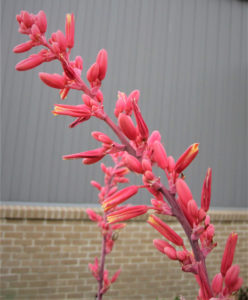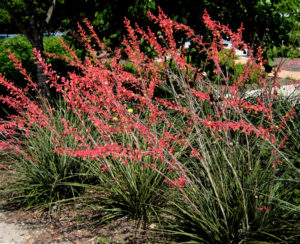Red yucca is latest Texas Superstar
Showy native succulent is Texas tough, thrives statewide
Red yucca, a versatile and tough native Texas succulent, was named the newest Texas Superstar plant.

Red yucca, also known as pink yucca, red-flowered yucca, soft-tip yucca or samadoque, is a favorite plant among gardeners in the southwestern U.S. The native plant resembles a cross between other common spine-pointed yuccas and aloe.
It is an herbaceous shrubby perennial succulent with evergreen foliage and can be long-lived, said Greg Grant, Texas A&M AgriLife Extension Service horticulturist, Smith County.
“Red yuccas are one of those plants we should all be utilizing,” he said. “They thrive in most parts of Texas in alkaline to acidic soils. It is tough to find a plant that is adapted to Texas as well as red yucca.”
Get to know the red yucca
Plant leaves are thicker than those of other yuccas, but more sword-shaped than aloe. Red yuccas’ dark green leaves arise from a slowly suckering clump forming a cluster of rosettes. The rosettes produce tubular flowers with trumpet-shaped flared tips.
Flowers are typically 4–5-inch pale pink spikes or narrow sparsely branched panicles of coral or salmon-pink. Rarely they are red or yellow, 1-2 inch tubular flowers with trumpet-shaped flared tips. They often flower multiple times through the growing season.
Flowers often occur as spikes on younger plants, with older established plants producing larger branched panicles. Deadheading spent flowers will improve plant appearance and avoid growth resource diversion from bloom development.
“Once they start flowering, it is hard to catch them without flowers up to the first frost,” Grant said. “Coral-colored flowers are the standard, but they do come in yellow and a darker red.”
Grant said plants are amazingly diverse and can thrive in a variety of soils and perform well under dry, hot conditions. They are also excellent pollinator support plants and an attractive addition to any pollinator garden.
To be designated a Texas Superstar, a plant must perform well for growers throughout the state. Texas Superstars must also be easy to propagate, ensuring the plants are widely available and reasonably priced.
Red yucca maintenance, care
Red yucca is a sun-loving plant, but can survive in partial shade, though blooms will be reduced. They also tolerate reflected heat and wind exposure.
Plants are very drought and heat tolerant once established. Container-grown plants can be planted from early spring through fall.
“This is a great plant for hot, dry, exposed locations,” he said.
Red yucca can survive in U.S. Department of Agriculture hardiness Zone 6-13 and perhaps protected locations in Zone 5b. They tolerate moderate salinity in water and soils.
Soils that drain well are necessary for red yucca. Plants are soil-pH adaptable and are particularly tolerant of limestone and caliche soils as long as the location drains well. They also perform well in low fertility locations but will grow more vigorously where adequate nutrients are available.
“These plants are foolproof if you avoid overwatering,” Grant said. “So, well-drained soil is a must for red yucca. Aside from that, they require very little tending.”
Suggested uses for red yucca
Red yucca can enhance a wide range of landscape designs, more so than many xeric succulents, Grant said. Plants offer showy flowers over long periods of time and the clumps spread slowly enough to allow the foliage to serve as an alternative to small shrubs.

It is an obvious choice for rock gardens and xeric landscapes. Red yucca makes a nice accent or small-scale groundcover beneath mesquite, paloverde or other trees with light filtered shade. The lack of sharp points on the leaves, hence its alternate name of soft-leaf yucca, makes red yucca suitable for use where pedestrian traffic may contact it.
Dry slopes, rocky outcroppings and patio containers are other good options for red yucca. And the repeated flowering makes it a valuable addition to pollinator gardens.
Red yucca is widely available at nurseries and retail garden centers around Texas, Grant said. Dwarf forms, hybrids with other species of Hesperaloe as well as new selections with red or yellow flowers, further diversify the plant’s potential ornamental uses.
“Red yucca is the perfect Earth-Kind plant,” Grant said. “It is one of those rare plants that is not picky about soil or moisture availability and is showy most of the year.”
Texas Superstar is a registered trademark owned by Texas A&M AgriLife Research. Plants are designated by the Texas Superstar executive board, which comprises nine horticulturists from AgriLife Research, AgriLife Extension and Texas Tech University.





